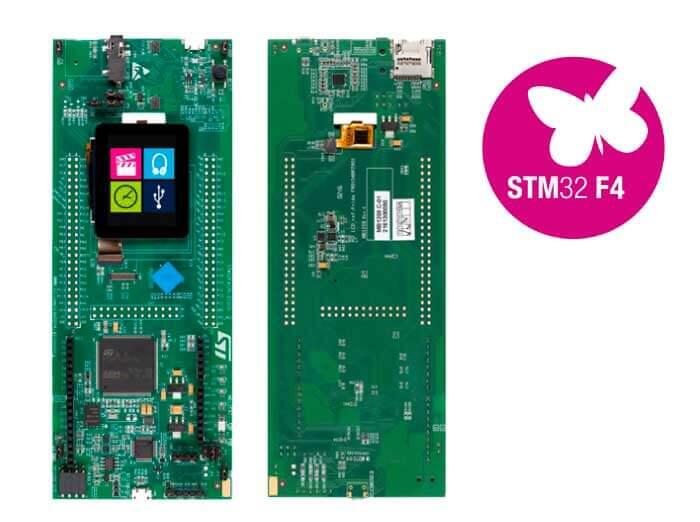ST STM32F412G Discovery
Overview
The STM32F412 Discovery kit features an ARM Cortex-M4 based STM32F412ZG MCU with a wide range of connectivity support and configurations Here are some highlights of the STM32F412G-DISCO board:
STM32F412ZGT6 microcontroller featuring 1 Mbyte of Flash memory and 256 Kbytes of RAM in an LQFP144 package
On-board ST-LINK/V2-1 SWD debugger supporting USB re-enumeration capability:
USB virtual COM port
mass storage
debug port
1.54 inch 240x240 pixel TFT color LCD with parallel interface and capacitive touchscreen
I2S Audio CODEC, with a stereo headset jack, including analog microphone input and a loudspeaker output
Stereo digital MEMS microphones
MicroSD card connector extension
I2C extension connector
128 Mbit Quad-SPI Nor Flash
Reset button and Joystick
Four color user LEDs.
USB OTG FS with Micro-AB connector
Four power supply options:
ST-LINK/V2-1 USB connector
User USB FS connector
VIN from Arduino* connectors
5 V from Arduino* connectors
Two power supplies for MCU: 2.0 V and 3.3 V
Compatible with Arduino(tm) Uno revision 3 connectors
Extension connector for direct access to various features of STM32F412ZGT6 MCU
Comprehensive free software including a variety of examples, part of STM32Cube package

More information about the board can be found at the 32F412GDISCOVERY website.
Hardware
STM32F469I-DISCO Discovery kit provides the following hardware components:
STM32F412ZGT6 in LQFP144 package
ARM® 32-bit Cortex® -M4 CPU with FPU
100 MHz max CPU frequency
VDD from 1.7 V to 3.6 V
1 MB Flash
256 KB SRAM
GPIO with external interrupt capability
LCD parallel interface, 8080/6800 modes
1x12-bit ADC with 16 channels
RTC
Advanced-control Timer
General Purpose Timers (12)
Watchdog Timers (2)
USART/UART (4)
I2C (4)
SPI (5)
SDIO
2xCAN
CRC calculation unit
True random number generator
DMA Controller
- More information about STM32F412ZG can be found here:
Supported Features
The Zephyr stm32f412g_disco board configuration supports the following hardware features:
Interface |
Controller |
Driver/Component |
|---|---|---|
NVIC |
on-chip |
nested vector interrupt controller |
UART |
on-chip |
serial port-polling; serial port-interrupt |
PINMUX |
on-chip |
pinmux |
GPIO |
on-chip |
gpio |
I2C |
on-chip |
i2c |
SPI |
on-chip |
spi |
QSPI NOR |
on-chip |
off-chip flash |
Other hardware features are not yet supported on Zephyr porting.
The default configuration can be found in the defconfig file:
boards/arm/stm32f412g_disco/stm32f412g_disco_defconfig
Pin Mapping
STM32F412G-DISCO Discovery kit has 8 GPIO controllers. These controllers are responsible for pin muxing, input/output, pull-up, etc.
For more details please refer to 32F412GDISCOVERY board User Manual.
Default Zephyr Peripheral Mapping:
UART_2_TX : PA2
UART_2_RX : PA3
LD1 : PE0
LD2 : PE1
LD3 : PE2
LD4 : PE3
System Clock
STM32F412G-DISCO System Clock could be driven by internal or external oscillator, as well as main PLL clock. By default System clock is driven by PLL clock at 100MHz, driven internal oscillator.
Serial Port
The STM32F412G Discovery kit has up to 4 UARTs. The Zephyr console output is assigned to UART2. Default settings are 115200 8N1.
Programming and Debugging
Applications for the stm32f412g_disco board configuration can be built and
flashed in the usual way (see Building an Application and
Run an Application for more details).
Flashing
STM32F412G-DISCO Discovery kit includes an ST-LINK/V2 embedded debug tool interface. This interface is supported by the openocd version included in Zephyr SDK.
Flashing an application to STM32F412G-DISCO
Connect the STM32F412G-DISCO Discovery kit to your host computer using the USB port, then run a serial host program to connect with your board:
$ minicom -D /dev/ttyACM0
Then build and flash an application. Here is an example for the Hello World application.
# From the root of the zephyr repository
west build -b stm32f412g_disco samples/hello_world
west flash
You should see the following message on the console:
Hello World! arm
Debugging
You can debug an application in the usual way. Here is an example for the Hello World application.
# From the root of the zephyr repository
west build -b stm32f412g_disco samples/hello_world
west debug
